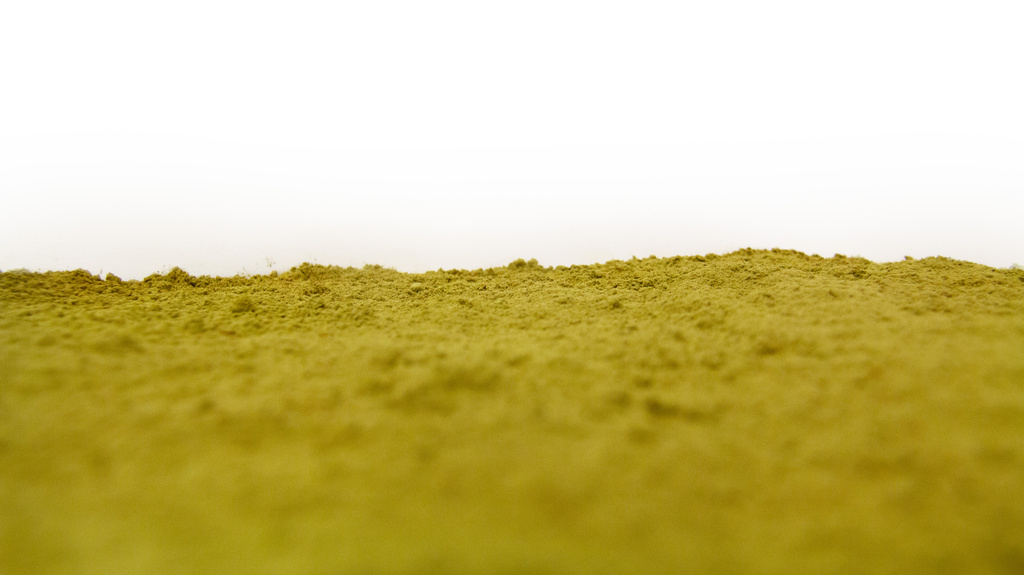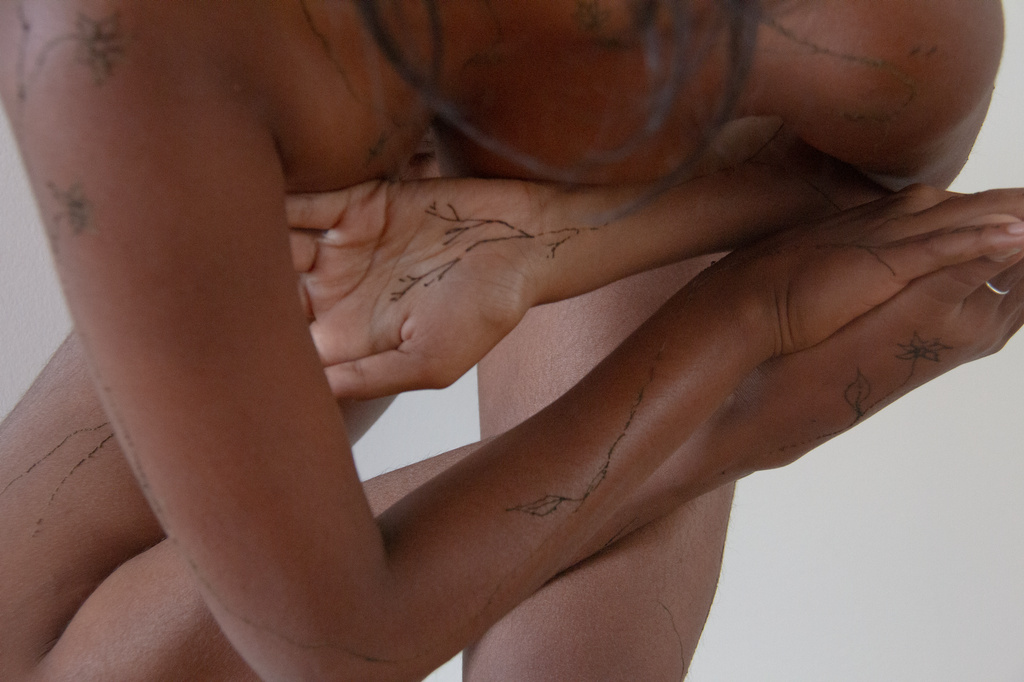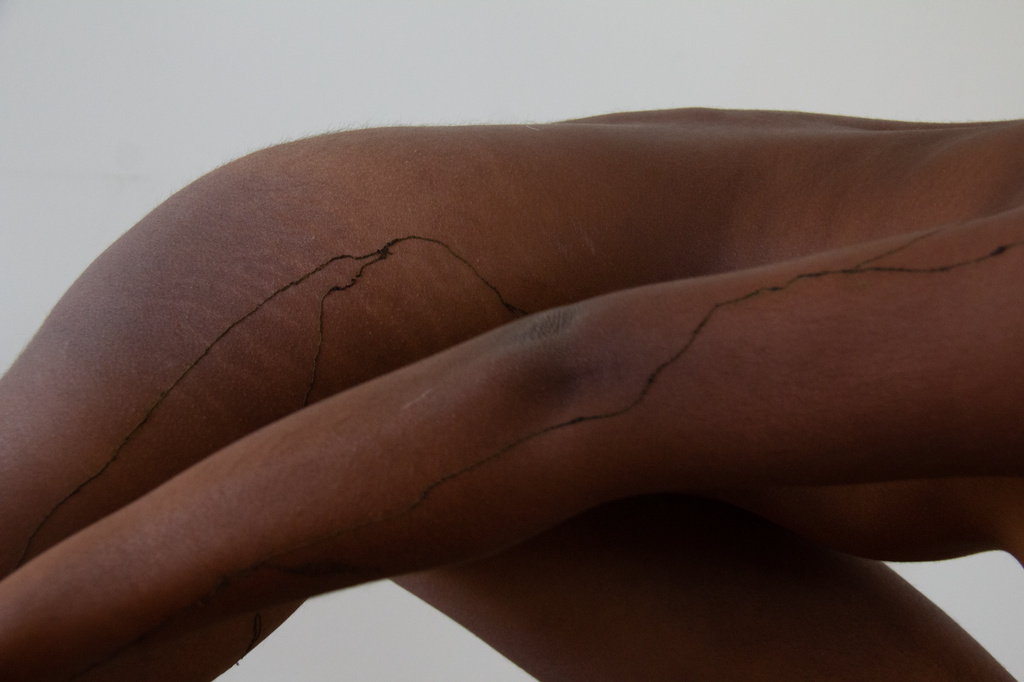
In choosing henna as her medium, Samika Rao must continually re-create her work, reflecting natural cycles.
Henna is a material of meditation. It is personal, political, decorative, formal and familial. Its touch is cooling, smell is earthly, tradition is truthful, colour is deep, dark and time is ephemeral and durational. A powerful medium that encapsulates the many states and qualities of time, of pasts, presents and futures.
Bringing consciousness to the present moment is a meditation in our current state.
Repeating ritual and traditional practices, it respects the past.
A form of celebration and manifestation for the future holds hope.
The process of henna is a process of time, and I will walk you through it. The plant, Lawsonia Inermis, grows, then we pluck the leaves and wait for them to dry. Once they are dried, they are crushed in sunlight-free henna mills. The henna powder is mixed with water, lemon and oils, left to sit for hours, days. The paste (and past) is packed into cones and cones into boxes, sent across the world in an aunty’s suitcase or Amazon. I prefer aunty. Packed with a bag of fresh hot food, the henna arrives into my hands, a strange brown woman that was born in Australia and is in love with India, through the knowledge of her mother and grandmother. The knowledge has been passed through tongues, spices, songs, scriptures, smells, skin, henna, and on these hands from the age of four. Once my hands were able, they learnt how to apply henna on my mother, my aunties, my grandmother, and my father (frustratingly in hidden spots). For over 10 years now, I have gone through the boxes from the aunties. I can now teleport and time-travel as I apply lines onto skin. Here is how I travel.
Henna, applied intricately, stains the skin and darkens to a deep red-brown, holds Eastern Philosophies in its body, shared with its sibling, rangoli, a white powder sieved through the hand, drawing mandalas in front of houses.
Traditionally, organic materials applied to skin or streets, decorated with attention and intention, are enjoyed and understood to change and fade in time.
Like the practice of mandala sand painting in Tibetan Buddhism, which is created and swept away, the temporary nature of henna and rangoli serves as a reminder of impermanence. This awareness of ephemerality encourages mindfulness of and non-attachment to each moment. Watching something beautiful fade away from your skin and finding the beauty in that, too. It reminds me of the Japanese concept Wabi Sabi, of finding beauty in “imperfections”, to find beauty in the growth and decay of a flower, it is all part of its bloom. The application of material to the surface requires attentiveness and presence to what is happening now. This concentration is a form of meditation. Indian philosophies speak of the Sanskrit term Ksana, translating to now, moment, instant. It is the shortest possible span of time, serving as both a unit of measurement and a spiritual symbol.
Henna holds space for this philosophy as there is a heightened appreciation for the present state, from doing to being. Ksana views time as a series of fleeting moments, each unique and transient, encouraging presence and non-attachment, challenging Western notions of time as a linear commodity that is future and efficiency-oriented. This sense of now does not disregard the importance of the past or future but offers a peaceful present state from which we can relate to the past and future with clarity. The practice of henna through the lens of ksanas only uplifts the past and present rather than negates them.
As a practice, applying and receiving henna is meditative, even hypnotic. Thoughts may be quiet, like a stream. But in this present state, enriched with mesmerising flowing patterns, pungent smells and cooling touch, the past is also present. This ritual, surviving centuries and colonies, remains alive each time it is practised.
The stain fades, but its practice and tradition persist, regenerating through each new ritual and design. This is how the brown girl feels bravely, beautifully brown…
Henna challenges the linear view of time, sharing a regenerative cyclical understanding of time that I have also learnt from the storytelling of the First Nation Peoples of Australia. Henna, like the First Peoples’ understanding of time, embodies a non-linear, cyclical process. When applied, henna gradually darkens and fades. But it doesn’t “end” in the Western sense: it dissolves back into nature, ready to be applied anew, reflecting an ongoing circle of creation, transformation, and renewal. Much like the Rainbow Serpent’s endless cycle of regeneration, which Tyson Yunkaporta speaks of powerfully (see further reading), where creation is never entirely destroyed but transformed, henna too resists the notion of finality. The stain fades, but its practice and tradition persist, regenerating through each new ritual and design. This is how the brown girl feels bravely, beautifully brown, with her roots remaining real.
Henna is a symbol of joy in many religions. It is an accessible means of decoration, adoration and celebration. These are times of intentional pausing—moments when time slows down, and both artist and wearer are fully present in the ritualistic space. Henna, in this sense, is a tool for marking time. It marks a moment. The stain of henna is believed to bring a prosperous future. For example, in bridal henna (also known as mehendi in South India), the darkness of the stain is said to predict the depth of love the couple will hold. This is philosophy of intention, manifestation, belief, hope, fate – a faithful or fearful way of relating to future. The ephemeral stain marks the transition from one stage of life to another and celebrates it. It is both transient on the body and continuous in its cultural importance.
As a conceptual and henna artist, the material itself is as potent in symbolism as it is in scent and sight. I work with henna in a method of abstraction, always honouring its roots and mine, but departing from tradition as I do. I play and pray with patterns and surfaces, such as dying fabrics with henna, applying it in vines throughout my body, continuing on to walls, building a 5-meter-long steel tray to hold it in its powder form.
I work with nature and the body, time is found in my processes, performances and documentation. We are all part of the earth and cosmos, yet we are now so far removed from our earth, fire, and tribe. We need these practices more than ever before.
Henna symbolises a cyclical nature of time and being: coming from the earth, connecting to the body to return to the earth. And each cycle gives rise to ritual and tradition. Whether in celebration, ritual, or adornment, henna brings a heightened awareness of time’s passage, reminding us of the beauty in impermanence and the interconnectedness of all things. I draw it and it draws me to this body, this earth.
Further Reading
Tyson Yunkaporta discusses in Sand Talk and the Rainbow Serpent Theory of Time that there is “a fundamental disagreement on the nature of reality and the basic laws of existence.” He states, “It all comes back to notions of time, and the existential acrobatics required for Second Peoples to make time run in a straight line, to create a beginning, middle and end of things. First Peoples’ law says that nothing is created or destroyed because of the infinite and regenerative connections between systems. Therefore, time is non-linear and regenerates creation in endless cycles.”
Tyson Yunkaporta, Rainbow Serpent Theory of Time, 2019, Garland Magazine
References
Jilani, Safia Z. 2023. “Science Henna: Sharing Stories through My Hands.” Sustainable Nano (blog). April 20, 2023.
“Time in Patañjali’s ‘Yogasūtra’ on JSTOR.” n.d. Accessed September 13, 2024.
“Time Was, Is, and Will Be.” n.d. Jivamukti Yoga (blog). Accessed September 10, 2024.
About Samika Rao
 Samika Rao is an artist who navigates her body and identity politics. Using line to flow and fragment between body, earth and spirit. Hairline, henna line, family line. Her cultural practices become a place for revealing and queering. Expressing via self-portraiture, henna, rangoli, light, paint and text in spatial conversations. Based in Naarm and Boorloo. Follow @artofsamika
Samika Rao is an artist who navigates her body and identity politics. Using line to flow and fragment between body, earth and spirit. Hairline, henna line, family line. Her cultural practices become a place for revealing and queering. Expressing via self-portraiture, henna, rangoli, light, paint and text in spatial conversations. Based in Naarm and Boorloo. Follow @artofsamika
Samika Rao, Victorian College of the Arts, 2024 Graduate Exhibition.



